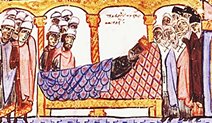|
The average life span of the Byzantine emperors was 52 years, without counting those with unknown birth dates or those who died before the age of 17.
The oldest emperors (at the end of their reign):
- Anastasius I, 491-518. Died at 88, reigned for 27 years
- Justinian I, 527-565. Died at 83, reigned for 38 years
- Nikephoros III, 1078-1081. Died at 80, reigned for 3 years
- Romanos I Lekapenos, 920-944. Died at 78, reigned for 24 years
- Justin I, 518-527. Died at 77, reigned for 9 years
- Basil I the Macedonian, 867-886. Died at 75, reigned for 19 years
- Manuel Palaiologos, 1391-1425. Died at 75, reigned for 34 years
The oldest emperors (at the time of their ascension):
- Justin I, 518. Emperor at 77, reigned for 9 years
- Nikephoros III Botaneiates, 1078. Emperor at 77, for 3 years
- Andronikos I Komnenos, 1183. Emperor at 65, for 3 years
- Constantine VIII, 1025. Emperor at 65, for 3 years
- Alexios V Murtzuphlos, 1204. Emperor at 64, for 3 months
- Anastasius I, 491. Emperor at 61, for 27 years
- Leo I the Thracian, 457. Emperor at 56, reigned for 17 years
The youngest emperors:
- Michael III the Drunkard, 842-867. Emperor at 2, for 25 years
- Theodosius II , 408-450. Emperor at 7, for 44 years
- Leo II, 474. Emperor at 7, for less than a year
- Constantine VII, 913-959. Emperor at 7, for 46 years
- Constantine VI the Blind, 780-797. Emperor at 9, for 17 years
- Alexios II Komnenos, 1180-1183. Emperor at 11, for 3 years
- John IV Doukas Laskaris, 1258-1261. Emperor at 8, for 3 years
- John V, 1341-1391. Emperor at 9, for 38 non consecutive years
- Constans II Pogonatus, 641-668. Emperor at 11, for 27 years
- Heraklοnas, 641. Emperor at 15, for some months
|






